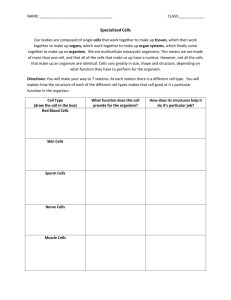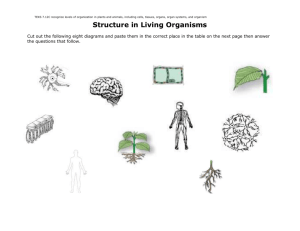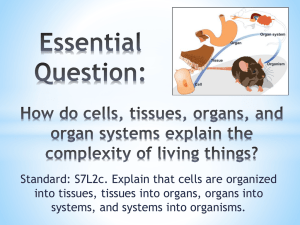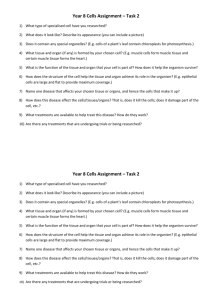2.2 How Living Things are Organized
advertisement
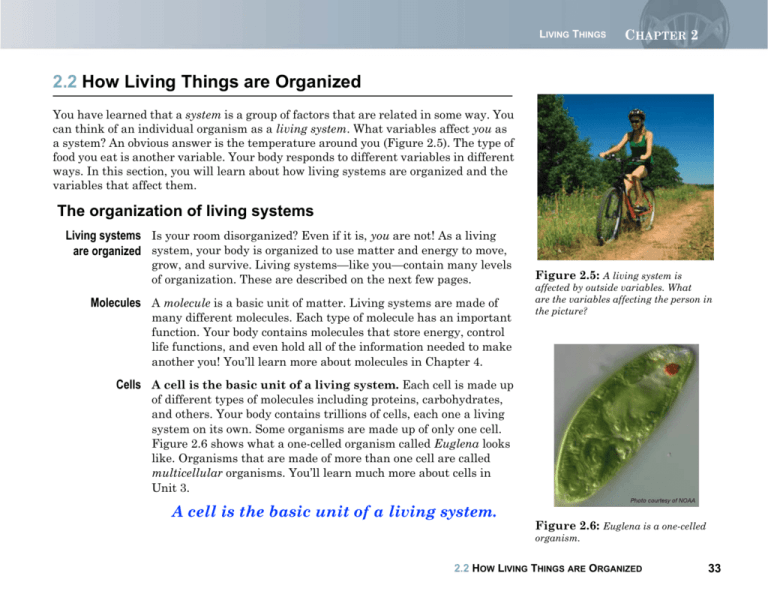
LIVING THINGS CHAPTER 2 2.2 How Living Things are Organized You have learned that a system is a group of factors that are related in some way. You can think of an individual organism as a living system. What variables affect you as a system? An obvious answer is the temperature around you (Figure 2.5). The type of food you eat is another variable. Your body responds to different variables in different ways. In this section, you will learn about how living systems are organized and the variables that affect them. The organization of living systems Living systems Is your room disorganized? Even if it is, you are not! As a living are organized system, your body is organized to use matter and energy to move, grow, and survive. Living systems—like you—contain many levels of organization. These are described on the next few pages. Molecules A molecule is a basic unit of matter. Living systems are made of many different molecules. Each type of molecule has an important function. Your body contains molecules that store energy, control life functions, and even hold all of the information needed to make another you! You’ll learn more about molecules in Chapter 4. Figure 2.5: A living system is affected by outside variables. What are the variables affecting the person in the picture? Cells A cell is the basic unit of a living system. Each cell is made up of different types of molecules including proteins, carbohydrates, and others. Your body contains trillions of cells, each one a living system on its own. Some organisms are made up of only one cell. Figure 2.6 shows what a one-celled organism called Euglena looks like. Organisms that are made of more than one cell are called multicellular organisms. You’ll learn much more about cells in Unit 3. A cell is the basic unit of a living system. Figure 2.6: Euglena is a one-celled organism. 2.2 HOW LIVING THINGS ARE ORGANIZED 33 CHAPTER 2 LIVING THINGS Tissues Your body is made up of many different types of cells. You have skin cells, muscle cells, liver cells, nerve cells, and blood cells, to name just a few. A group of specialized cells that performs a particular function is called a tissue. For example, muscle tissue is a tissue that is able to contract. Figure 2.7 shows what your muscle tissue looks like under a microscope. Organs Tissues combine to form organs, the next level of organization. An organ is a group of tissues that works together to carry out a set of functions. For example, your stomach is an organ that contains several types of tissue. Muscle tissue in your stomach contracts to mix food. Another type of tissue makes a chemical that breaks down the food. tissue - a group of specialized cells that performs a particular function. organ - a group of tissues that works together to carry out a set of functions. organ system - a group of organs that works together to perform a set of functions. Organ systems A group of organs that works together to perform a set of functions is called an organ system. For example, your digestive system consists of many organs including the esophagus, stomach, small intestine, and large intestine. Each organ in the system performs a different function that is part of the digestive process. Organism In multicellular organisms like you, different body parts and organ systems take on different functions. The network of organ systems works together to keep the organism alive. An organism is an independently functioning living thing. Figure 2.7: Muscle tissue is made of individual muscle cells. Each individual cell has a dark spot called a nucleus. 34 UNIT 1 LIVING SYSTEMS LIVING THINGS CHAPTER 2 Five levels of organization in multicellular organisms 2.2 HOW LIVING THINGS ARE ORGANIZED 35 CHAPTER 2 LIVING THINGS Variables and living systems Homeostasis Living things can respond to changes in their surroundings to maintain a steady internal environment. The process of maintaining a life-supporting system is called homeostasis. Homeostasis happens at all levels of organization, including the cellular level, and is a characteristic of all living things. homeostasis - the process of maintaining a life-supporting internal environment. Variables that All sorts of variables affect an organism’s ability to stay alive. affect life These include temperature, food, water, and the level of oxygen (Figure 2.8). All organisms have built-in processes to help them survive when variables change. Organisms can survive within a range of values for each variable. If a change in a variable is too severe, the organism may not be able to maintain homeostasis and could die. Why do we sweat You experience homeostasis every day, as you’ll see in the and shiver? following story. It was a hot day so Sarah decided to go for a swim in the neighborhood pool. She packed a towel and headed out on her bicycle. As Sarah climbed up a hill, she began to drip with sweat. She couldn’t wait to jump into the pool! When she started to swim though, the water was so cold she couldn’t stay in very long. Once Sarah got out of the water, she started shivering. The shivering stopped once she felt warm again. Sweating and shivering are examples of homeostasis 36 Sweating and shivering are good examples of how your body responds to maintain a steady temperature. Normal human body temperature is 37°C (98.6°F). At this temperature, your cells can perform their functions. When it’s too hot and your body temperature begins to rise, glands in your skin produce sweat to cool the temperature back down. When it’s too cold and your body temperature begins to lower, shivering is a response that warms your body temperature back up (Figure 2.9). UNIT 1 LIVING SYSTEMS Figure 2.8: A few variables that affect an organism’s ability to stay alive. Figure 2.9: Your normal body temperature is 37°C. Sweating and shivering are your body’s way of maintaining that temperature. LIVING THINGS CHAPTER 2 2.2 Section Review 1. 2. 3. 4. 5. Why is a living thing a system? Name three variables that affect a living system. What is a cell? What is a multicellular organism? Name three examples. Identify each picture below as either a molecule, a cell, a tissue, or an organ. Give a reason for your choices. 6. Explain why each of the following scenarios is a good example of homeostasis. What is the variable involved? What is the response? a. During the 100 meter run at a track meet, Sonja’s heart rate and breathing increased. b. Roberto’s stomach began to growl during science class. c. Because they do not have sweat glands, dogs pant when they’re hot. Like a living thing, a car has different levels of organization. A car is made of different materials like rubber and steel. Different materials are grouped into parts like the wheels and headlights. Different parts are grouped together into systems like the cooling system and the drive system. Together, all of the systems make up the car. Make a chart showing the levels of organization for one of the following systems. You may need to do some research! 1. 2. 3. 4. Your school building. A city. A cookie factory. Choose a system that is not listed. 2.2 HOW LIVING THINGS ARE ORGANIZED 37


